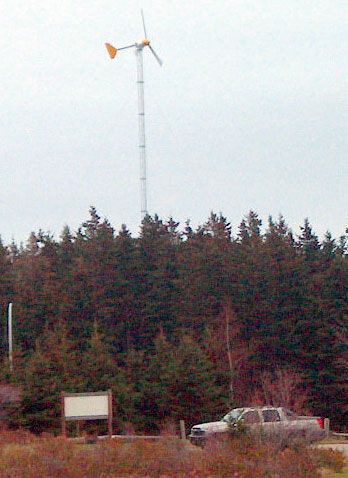page3
Taking the lead against greenhouse gases in national parks
Wind-power generation comes to Prince Edward Island National Park of Canada, while Riding Mountain National Park of Canada "greens its fleet" with electric cars
Two national parks are at the forefront of efforts to cut greenhouse gases while "doing business". Their initiatives are impressive and instructive for visitors.
At Prince Edward Island National Park of Canada, power generation has switched from the grid to wind power with the November 2004 installation of a wind turbine to power the Cavendish Campground. Part of a five-year rehabilitation project to improve the park's ecological integrity and visitor experience, the wind turbine is also a striking example of the park's leadership in promoting environmental stewardship.
The renewable energy produced by the turbine will reduce the park's greenhouse gas emissions by 20 tonnes of CO2, equivalent to the amount of CO2 produced by three Canadian households annually. Park visitors for the 2005 camping season will find new interpretive stations explaining the initiative and the need to reduce greenhouse gases. Visitors will learn that even the construction of the turbine followed strict environmental requirements, a further testament to the park's commitment to practicing good ecology. A wind-analysis survey determined the turbine's best location for minimal adverse impact on the environment. All construction activity occurred after the critical bird nesting period, and the clearing of undergrowth was kept to a minimum. As well, all unsalvageable wood was chipped and used on the site during the final rehabilitation phase.
The local community welcomed the turbine project, which was the first of its kind in Canada’s national parks system, and worked closely with staff. Many other organizations and groups collaborated on the project, including: Natural Resources Canada, Environment Canada, Canadian Wildlife Service, Transport Canada, Frontier Power System Inc., GPCo Inc. and Vision Quest Windelectric Company.
 Red electric car parked by a visitor centre © Parks Canada / K. Bachewich / 2003 |
With the introduction of electric cars to Riding Mountain National Park, park staff were delighted to have the means to tackle greenhouse gas emissions on an everyday basis. Previously, they had used large, older pickup trucks with less-efficient engines. The new electric cars–manufactured by Dynasty Motorcar of Delta, British Columbia–are completely battery powered, which means they don't emit harmful gases and are extremely quiet. The cars have plastic and fibreglass bodies, two seats and a large cargo area that is big enough to carry a two-metre stepladder. They can be used for a full workday, then plugged in overnight to be ready for the next morning.
Along with their immediate benefits to the environment, these zero-emissions cars provided another boon for park staff — the opportunity to "show off" how the average Canadian car owner can cut greenhouse gases. Staff were overwhelmed by the cars' impact on visitors. The vehicles triggered an avalanche of questions about their technology, cost and highway performance. Park staff received so many questions about the cars that it began to interfere with their work. To get the word out more efficiently, staff taped a set of frequently asked questions (and answers) to the cars' windshields, letting the parked cars "speak for themselves".
Results
First-ever installation of a wind turbine in a national park
 Wind turbine at Prince Edward Island National Park of Canada © Parks Canada / G. Shaw |
- Provides approximately 20% of the electrical needs of the Cavendish Campground on an annual basis.
- Reduces the park's greenhouse gas emissions by 20 tonnes of CO2, equivalent to the amount of CO2 produced yearly by three Canadian households.
- Offers an on-site demonstration of renewable energy for educational purposes.
- Earns revenue for the park, as electricity generated when the campground is closed is sold to the local utility.
- Has caused no bird or bat mortality since installation, as assessed by weekly monitoring.
Little electric cars match function to form cleanly
- Function very well as park vehicles and are 80% more efficient to operate than a gasoline equivalent.
- Provide zero tailpipe emissions.
- Reduce greenhouse gas emissions by 2 tonnes annually.
- Raise environmental awareness—especially as it relates to global warming and Canada's commitments under the Kyoto Protocol—as crowds of curious park visitors, suppliers and local community people press staff for information about the vehicles.
- Forced the retirement of over-sized, older pickup trucks with less-efficient engines.
- Reduce noise pollution, as battery-operated cars are extremely quiet.
- Date modified :